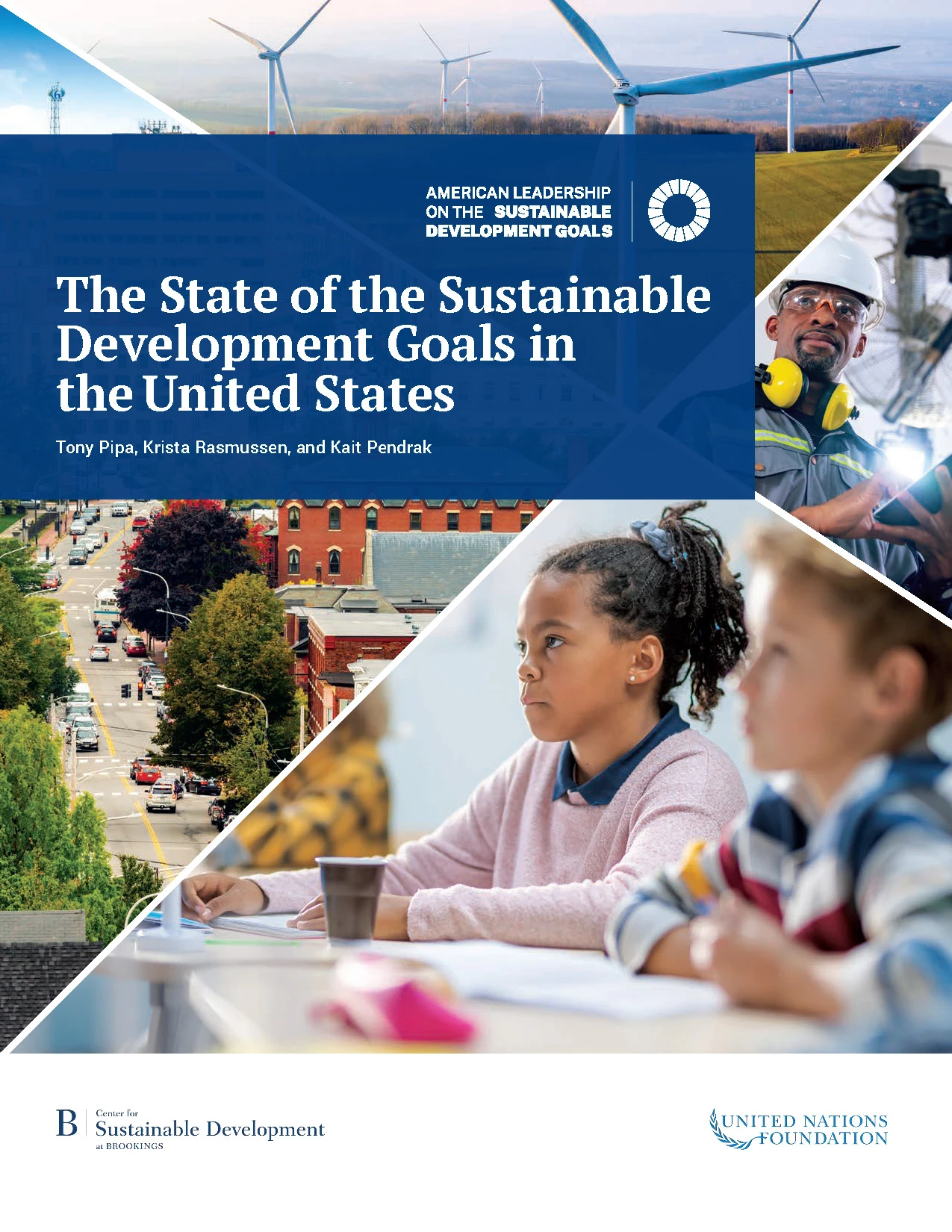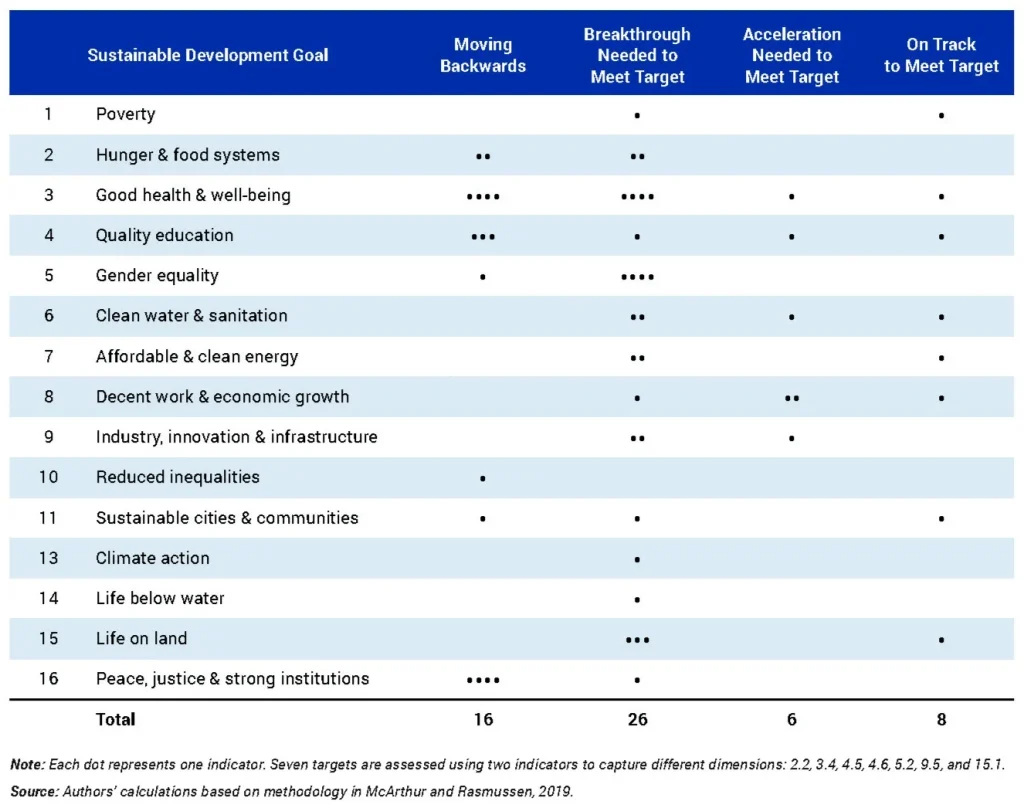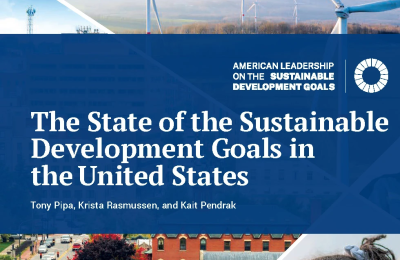This article is the first in a series of articles about a recently released report on the U.S. and its progress in achieving the Sustainable Development Goals. It serves as a brief introduction to the report, its major findings and recommendations. We highly recommended reading the full report, which raises critical issues of human development in American society and spotlights the urgent need for action in the U.S. to accelerate progress and innovation on the SDGs. Future articles will focus on specific issues raised in the report.

On 16 March 2022, the Center for Sustainable Development at Brookings in collaboration with the UN Foundation, released a report called “The State of the Sustainable Development Goals in the United States”.[1]
The report was written by Anthony F. Pipa, Krista Rasmussen and Kait Pendrak, all highly experienced in development and policy issues, and the sustainable development goals (SDGs) in particular.[2]
The SDGs are at the heart of the 2030 Agenda for Sustainable Development, which all United Nations Member States adopted in 2015. There are 17 SDGs; all are interconnected, and address major issues affecting every country, such as poverty, health, education, gender inequality, and protection of the environment.[3]
The report discussed the progress the United States has made in terms of meeting 56 indicators and achieving SDGs. To measure progress, the authors utilized a methodology (developed at the Brookings Institution) to estimate trajectories toward achieving the SDGs out to the 2030 deadline. The trajectories were divided into four categories: on track (trajectory achieved or on the way to achievement); acceleration needed (trajectory could achieve half the distance to the target but would still fall short of the target) breakthrough needed (trajectory could achieve less than half the distance to the target) and moving backwards (trajectory moving in the wrong direction).[5]
“Even before the pandemic, the U.S. is not on track to fully achieve a single SDG.”
It was found that the U.S. is lagging in the achievement of the SDGs, and that “even before the pandemic, the U.S. is not on track to fully achieve a single SDG.”[6] However, 8 indicators belonging to 8 SDGs are on track. 16 indicators belonging to 7 SDGs (hunger, health, education, gender inequality, other inequalities, sustainable cities, peace/justice) are considered as moving backwards. 26 indicators belonging to 15 SDGs need breakthroughs, and 6 indicators belonging to 5 SDGs need acceleration.[7]

Summary of U.S. domestic trajectories on 56 SDG-related indicators before COVID-19 (Page 4)
The report further identified urgent needs and gaps that should be addressed for the U.S. to move forward, meet indicators, and achieve SDGs. The seven major gaps cited were:
Inadequate progress on basic measures of human development (e.g. poverty, housing, food security and sanitation) leading to millions of people being left behind.
Mounting challenges faced by children and youth: lack of improvement in math and literacy proficiency; prevalence of childhood stunting and unhealthy weight; higher incidences of suicides.
Women face ongoing inequalities such as: the gender wage gap; lack of women in leadership; unpaid care work; reproductive healthcare; and intimate partner violence.
More action is needed to meet new emissions targets. While the U.S. has annually required less energy, consumed less material and produced fewer emissions compared to 2000, new emissions targets are not on track to being met.
Health and well-being challenges exist (even prior to the pandemic). Maternal mortality increased (with race and ethnicity disparities), overdose rates and suicide rates also increased, progress in reducing deaths from non-communicable diseases slowed, and essential health care had “only modest improvements”.
Measures of safety, justice and strength of institutions were declining. Physical and sexual violence rates stayed high, corruption in the public-sector increased, and public trust in the criminal justice system as well as access to justice waned.[8]
Recommendations
“The United States’ goal of enabling a transformative social and economic recovery, both nationally and globally, is well-reflected in the SDGs, both in substance and scope. […] By situating its objectives within the commonly accepted language and measures of the SDGs, the administration opens up significant opportunities for partnership, investment, and collaboration with a wide range of domestic and international stakeholders.”[9]
To address the identified needs and gaps, and to be able to achieve the SDGs, the authors proposed several recommendations to the U.S. government. These include:
Project strong political commitment to achieving the SDGs
Officials should publicly manifest high-level political commitment to the SDGs.
Government should commit to conducting a Voluntary National Review (VNR) to assess the country’s progress in achieving SDGs. The U.S. is the only G7, G20 and OECD country that has not submitted a VNR. The process of producing a VNR should engage national and state authorities, universities, companies, civil society groups, and other stakeholders.
Establish institutional arrangements to accelerate progress
Strengthen internal coordination between domestic policy leadership and US foreign policy apparatus through the creation of a cabinet-level SDG Council, co-chaired by the director of the Domestic Policy Council and the National Security Advisor.
Create a national roadmap for achieving SDGS that explains priorities, identifies targets to measure progress and finds gaps in progress.
Establish a data platform to create accountability and monitor progress and commit to regular reporting on SDG progress (reviving the previously established National Reporting Platform for SDG indicators and re-forming an Expert Group of SDG Indicators which would include non-governmental stakeholders).
Strengthen partnerships among stakeholders by hosting a US SDG Summit to reinforce existing action in communities and enable high-level government support.
Take steps to encourage innovation and SDG actions, for example, working with U.S. government scientists and research partners on areas where breakthroughs are needed.
Support civil society led shadow VNRs that parallel the U.S. Government’s VNR, and will assist in accountability and identify any gaps or needs that should be highlighted.
Increase public awareness of the SDGs through education and professional development
Start with government officials on all levels, and include SDGs into onboarding and training, and incorporating SDGs into standards in mandates and performance reviews.
Specific training for civil and foreign service officers to spur innovation and new approaches in program design and policy development. This would encourage multi-disciplinary problem-solving.[10]
The SDGs are wayposts the United States can follow to meet both domestic and international obligations. They can be used to created and strengthen partnerships between governmental and non-governmental (whether civil society or private sector) actors, to work toward outcomes that address the major issues that concern Americans, and would benefit all.
[1] The 21-page report, its executive summary, references and annexes can be downloaded from the Brookings Institution website, https://www.brookings.edu/research/the-state-of-the-sustainable-development-goals-in-the-united-states/ [2] Anthony F. Pipa is a senior fellow in the Global Economy and Development Program at the Brookings Institution, and he led the U.S. delegation to the United Nations to develop the SDGs (see https://foreignpolicy.com/author/anthony-f-pipa/ ) Krista Rasmussen is an Officer of Policy and Research in the Policy Planning team at the United Nations Foundation (https://unfoundation.org/author/krista-rasmussen/) while Kait Pendrak is an associate of U.S. SDGs in policy planning at the UN Foundation (https://www.brookings.edu/author/kaitlyn-pendrak/). [3] For more information on the SDGs, visit the following site: https://sdgs.un.org/goals [4] See https://sdg-tracker.org/ [5] Pages 2-3, The State of the Sustainable Development Goals in the United States, https://www.brookings.edu/research/the-state-of-the-sustainable-development-goals-in-the-united-states/ [6] Id. at p. 4. Due to the pandemic, the authors had to rely on data from 2019. [7] See Figure 2. Summary of U.S. domestic trajectories on 56 SDG-related indicators before COVID-19, Ibid. [8] Pages 6-7, The State of the Sustainable Development Goals in the United States, https://www.brookings.edu/research/the-state-of-the-sustainable-development-goals-in-the-united-states/ [9] Id. at p. 19. [10] Pages 19-21, The State of the Sustainable Development Goals in the United States, https://www.brookings.edu/research/the-state-of-the-sustainable-development-goals-in-the-united-states/



